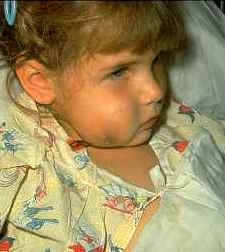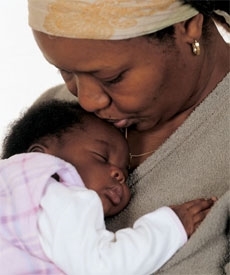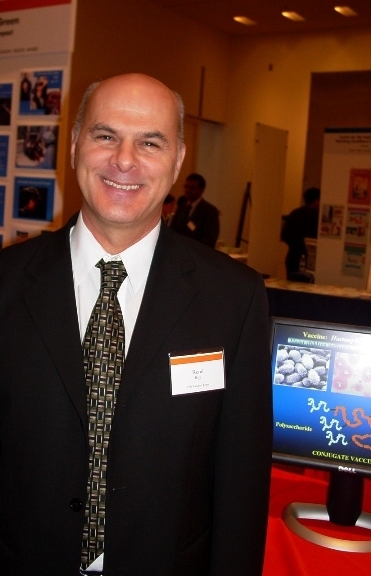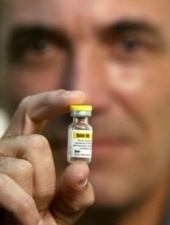 |
| The HIB Team: Dr. Vicente Verez-Bencomo of Cuba and Dr. René Roy of Canada, Image from the University of Ottowa. (article in French) |
The Haemophilus influenzae type b bacteria, also known as Hib, is estimated to cause over 3 million cases of serious disease worldwide, and hundreds and thousands of deaths (700,000 of those children, 500,000 of them infants) each year. It particularly affects children under the age of 5.
Hib disease is dangerous in that it can spread from person to person, as it is commonly found lining the surface of the nose and the back of the throat. But while most adults have developed an immunity to it, young children are at greater risk of infection.
The bacteria can cause a handful of severe illnesses in children, specifically bacterial pneumonia, epiglottitis (severe swelling in the throat that makes it hard to breathe), and childhood meningitis (an infection of the membranes lining the brain and spinal cord). Meningitis is considered highly dangerous as it can cause long-term brain damage and deafness in children, and is fatal in many cases. Those who do survive often suffer from various complications including mental retardation and seizures. Haemophilus influenzae also causes other serious infections, especially in the blood, joints, bones, skin, and covering of the heart.
 |
| Swelling caused by Hib infection: Photo Courtesy of the Children's Immunization Project |
The Hib vaccine was approved for young children in 1990, and has been very successful in having dramatically reduced bacterial meningitis infections in children and infants. The rate of invasive Hib infections, in general, has fallen 98 percent, and amongst children under 5, by 99 percent.
Hib is a problem worldwide, but has been controlled in developed nations which offer the vaccine. Prior to the vaccine, for example, every year roughly 20,000 people were infected with Hib, and two-thirds of those patients developed meningitis. One out of every 200 U.S. children under the age of 5 was infected with an Hib disease, and 600 died each year from meningitis.
 |
| Photo from Immunisation for Life |
Accordingly, the Hib Vaccine is recommended for all children. Yet many parents in the developing world do not have access to it because of its limited availability, and because of its high production costs, they cannot afford it even when it is available. The vaccine requires a series of 3 shots over the course of a year, to be fully effective, again, making it impossible for some parents to provide their children with this preventative treatment.
The Hib vaccine is also recommended for adults with sickle cell disease, HIV/AIDS, those who have had a bone marrow transplant, who have had their spleen removed, or who have undergone treatment for cancer.
The Hib Vaccine Team led by Vicente Verez-Bencomo of Cuba and Rene Roy of Canada, developed a synthetic version of the Hib vaccine, which can be produced at a much lower cost. The currently licensed Hib vaccine is made from the sugar coating (polysaccharide) of the bacteria itself and linked to a protein. The alternative vaccine uses native polysaccharide which has been shown to be just as effective in humans. Their innovative vaccine is produced by chemical synthesis rather than the conjugate vaccine most widely used today in industrialized nations.
By exposing children to only the polysaccharide coating, rather than the disease itself, a protective immune response is produced, dramatically reducing the risk of disease upon the child's first encounter with natural Hib.
This lower-cost alternative provides access to the Hib vaccine for those who otherwise would not have been able to afford or obtain access to it. More than one million doses of it have already been administered in Cuba and the team is working to introduce it into other countries as well.
 |
| Rene Roy of Canada, part of the Hib Vaccine Team |
Please tell us more about your work...
My name is Rene Roy; I'm French-Canadian; I'm from the University de Quebec in Montreal; I work in the chemistry department, and together with a Cuban scientist we discovered the first synthetic vaccine that is threatening bacterial infections causing meningitis especially in kids in developing countries..... We have discovered the first synthetic vaccine that is capable of treating the kids that are inflicted by these infections which are killing more than a half million kids per year.
We have a plan that will make the vaccine more affordable for developing countries. The vaccine is safer since you don't need the bacterial growth or any components of the bacteria to make the vaccine. Everything we have done is synthetic material, like you would in a drug or pill like aspirin, so quality control is excellent.
We are on the verge of eradicating the disease in Cuba and soon, hopefully, that could be elsewhere, all over the world.
This disease, as I mentioned, is killing more than a half million people yearly in developing countries. Especially youngsters two years of age and less.... The disease is causing meningitis and pneumonia, depending on where the disease first sits and infects you. Kids that survive these infections may have irreversible brain damage that can end up [causing] death or mental retardation.
 |
| New Cuba vaccine against pneumonia and meningitis |
What is the cost involved for these vaccines?
The actual existing vaccines made of the bacteria itself are costing about $5 a dosage. We are hoping that with this new synthetic vaccine we are downsizing that figure to $1, maybe $1.50 maximum per dosage.
(on Cuba)
Cubans have probably the best medicare system in the world. Surprisingly also, on a per capita basis there are more physicists and doctors in Cuba than [anywhere else] in the world. So this is a very nice place where if you have any kind of disease, you can be treated through surgery or anything like that at a free cost.
Where does your work expand to after Cuba?
We hope to achieve partnerships with countries in Latin America, especially Brazil and Venezuela. It is likely that this vaccine will go into those countries. Then hopefully afterwards, since the disease is prevalent, then China, Africa, India and other foreign countries will be the next target.
Who's your hero?
I'm a chemist and like physical science so Albert Einstein was one of my heroes. On the opposite scene of that, I like Bill Gates and his wife, because, as you know, they created the Bill Gates Foundation and they are giving a lot of money to developing countries to help their healthcare systems.
Page created on 8/16/2014 6:07:11 PM
Last edited 4/26/2021 11:16:13 PM
